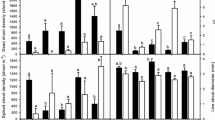Abstract
Biomechanical plasticity and within-species growth form diversity are traits that can facilitate invasion by non-native plant species. We support this argument with evidence from the invasion of coastal habitats in northern Florida, USA, by Schinus terebinthifolius and describe some of the consequences of this invasion for overtopped saltmarsh plants. In crowded stands, Schinus grows more like a vine than a tree, with stem height : diameter ratios nearly twice than those observed in open-grown individuals but with no changes in wood density or the modulus of elasticity of stem material. When extracted from the surrounding vegetation, the formerly crowded Schinus stems buckle under their own weight. Schinus crowns also extend much further over adjacent saltmarsh than crowns of Juniperus virginiana, the only other tree species abundant in the study site. Along forest edges, the above-ground biomass of saltmarsh plants overtopped by Schinus crowns was reduced by more than an order of magnitude. The biomechanical plasticity of Schinus allows it to adapt its growth form to suit habitat conditions and can dominate the edges of salt marshes as a sprawling shrub and maritime forests as either a free-standing tree or a woody vine, depending on stand crowding
Similar content being viewed by others
References
MM Brinson RR Christian (1999) ArticleTitleStability of Juncus roemerianus patches in a salt marsh Wetlands 1 171–191
K Claridge SB Franklin (2002) ArticleTitleCompensation and plasticity in an invasive plant species Biological Invasions 4 339–347 Occurrence Handle10.1023/A:1023671006342
MB Dickinson FE Putz CD Canham (1993) ArticleTitleCanopy gap closure in thickets of the clonal shrub, Cornus racemosa Bulletin of the Torrey Botanical Club 120 439–444
V Dunevitz J Ewel (1981) ArticleTitleAllelopathy of wax myrtle (Myrica cerifera) on Schinus terebinthifolius Florida Scientist 44 13–20
SML Ewe SL L Sternberg Particleda (2002) ArticleTitleSeasonal water-use by the invasive exotic, Schinus terebinthifolius, in native and disturbed communities Oecologia 133 441–448 Occurrence Handle10.1007/s00442-002-1047-9
Ewel JJ, Ojima DS, Karl DA and Debusk WF (1982) Schinus in successional ecosystems of Everglades National Park. South Florida Research Center Report T-676, 141 pp
F Gallenmüller U Müller N Rowe T Speck (2001) ArticleTitleThe growth form of Croton pullei (Euphorbiaceae) – functional morphology and biomechanics of a neotropical liana Plant Biology 3 50–61
BL Gartner (1991) ArticleTitleIs the climbing habit of poison oak ecotypic? Functional Ecology 5 696–704
NM Holbrook FE Putz (1989) ArticleTitleInfluence of neighbors on tree form: effects of lateral shade and prevention of sway on the allometry of Liquidambar styraciflua (sweetgum) American Journal of Botany 76 1740–1749
JL Horton HS Neufeld (1998) ArticleTitlePhotosynthetic responses of Microstegium vimineum (Trin.) A. Camus, a shade-tolerant C4 grass, to variable light environments Oecologia 114 11–19 Occurrence Handle10.1007/s004420050414
RN Mack (2003) ArticleTitlePhylogenetic constraint, absent life forms, and preadapted alien plants: a prescription for biological invasions International Journal of Plant Sciences 164 S185–S196 Occurrence Handle10.1086/368399
CL Montague RG Wiegert (1995) Salt marshes RL Myers JJ Ewel (Eds) Ecosystems of Florida. University of Central Florida Press Orlando, Florida, USA 481–516
L Mytinger GB Williamson (1987) ArticleTitleThe invasion of Schinus into saline communities of Everglades National Park Florida Scientist 50 7–12
KJ Niklas (1994) Plant Allometry: The Scaling of Form and Process The University of Chicago Press Chicago, Illinois, USA 395
I Olmsted S Yates (1984) ArticleTitleFlorida’s pepper problem Garden 8 20–23
FD Panetta J McKee (1997) ArticleTitleRecruitment of the invasive ornamental, Schinus terebinthifolius, is dependent upon frugivores Australian Journal of Ecology 22 432–438
FE Putz (1984) ArticleTitleThe natural history of lianas on Barro Colorado Island, Panama Ecology 65 1713–1724
C Raunkiaer (1934) The Life Forms of Plants and Statistical Plant Geography, Being the Collected Papers of C. Raunkiaer Clarendon Press Oxford, UK
SH Reichard CW Hamilton (1997) ArticleTitlePredicting invasions of woody plants introduced into North America Conservation Biology 11 193–203 Occurrence Handle10.1046/j.1523-1739.1997.95473.x
M Rejmánek DM Richardson (1996) ArticleTitleWhat attributes make plant species more invasive? Ecology 77 1655–1661
RJ Roark WC Young (1975) Formulas for Stress and Strain McGraw-Hill Book Company New York, USA 624
NP Rowe T Speck (1996) ArticleTitleBiomechanical characteristics of the ontogeny and growth habit of the tropical liana Condylocarpon guianense (Apocynaceae) International Journal of Plant Sciences 157 406–417 Occurrence Handle10.1086/297357
JR Runkle TC Yetter (1987) ArticleTitleTreefalls revisited: gap dynamics in the southern Appalachians Ecology 68 417–424
D Simberloff DC Schmitz TC Brown (Eds) (1997) Strangers in Paradise: Impact and Management of Nonindigenous Species in Florida Island Press Washington, DC, USA 467
AJ Symstad (2000) ArticleTitleA test of the effects of functional group richness and composition on grassland invasibility Ecology 81 99–109
GR Trimble ER Tryon (1966) ArticleTitleCrown encroachment into openings cut in Appalachian hardwood stands Journal of Forestry 64 104–108
PM Vitousek (1986) ArticleTitleBiological invasions and ecosystem properties: can species make a difference? Ecological Studies 58 163–176
B Holle ParticleVon D Simberloff (2004) ArticleTitleTesting Fox’s assembly rule: does plant invasion depend on recipient community structure? Oikos 105 551–563
SA Wainwright D Biggs JD Currey JM Gosline (1976) Mechanical Design in Organisms Princeton University Press Princeton, New Jersey, USA 423
K Williams KC Ewel RP Stumpf FE Putz TW Workman (1999) ArticleTitleSea-level rise and coastal forest retreat on the west coast of Florida, USA Ecology 80 2045–2063
TP Young SP Hubbell (1991) ArticleTitleCrown asymmetry, treefalls, and repeat disturbance of broad-leaved forest gaps Ecology 72 1464–1471
Author information
Authors and Affiliations
Corresponding author
Rights and permissions
About this article
Cite this article
Spector, T., Putz, F.E. Biomechanical Plasticity Facilitates Invasion of Maritime Forests in the southern USA by Brazilian pepper (Schinus terebinthifolius). Biol Invasions 8, 255–260 (2006). https://doi.org/10.1007/s10530-004-5571-x
Received:
Accepted:
Issue Date:
DOI: https://doi.org/10.1007/s10530-004-5571-x




